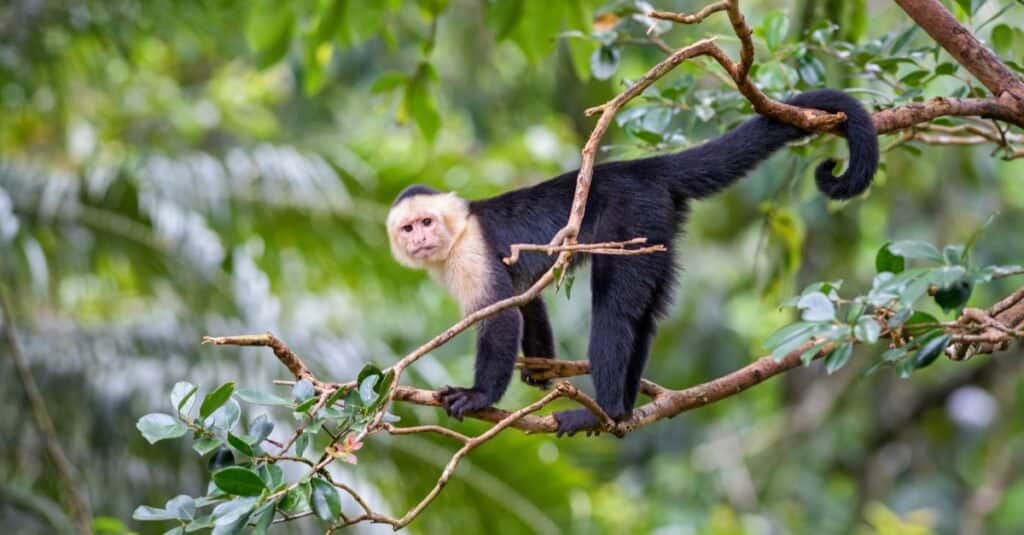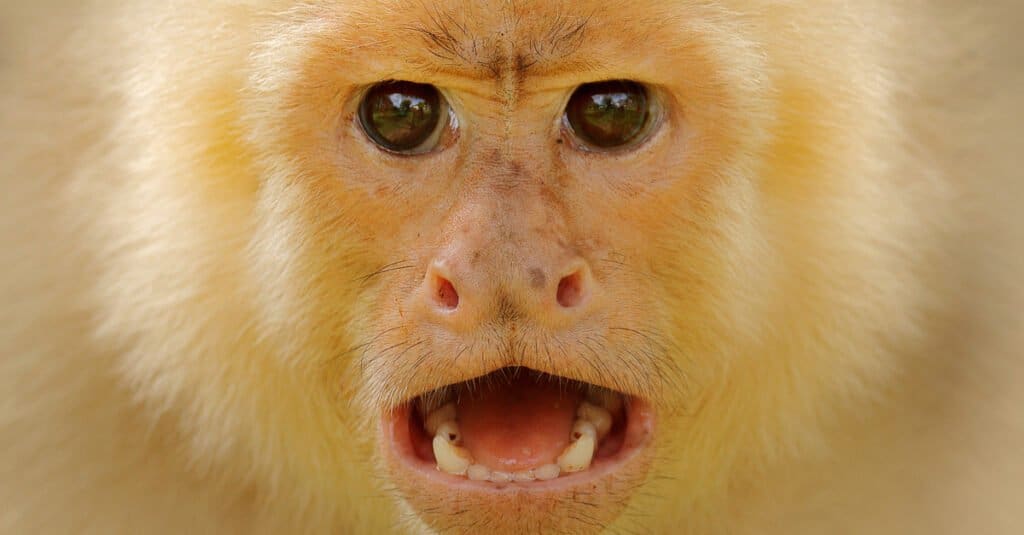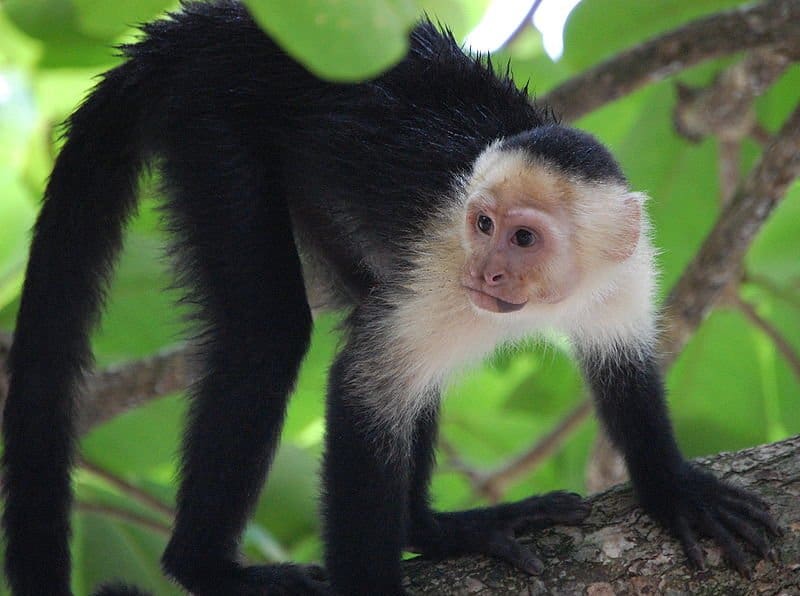Capuchin monkeys are famous for appearances in films and television, but do capuchins make good pets? The capuchin monkey originates from the tropical forests of South and Central America. Capuchins got their name from 15th-century Portuguese explorers. Their dark brown heads and backs reminded the explorers of friar caps and robes worn by an order of monks called Capuchin. The monkeys’ faces, necks, and upper arms are usually off-white or cream, depending on the species.
Capuchins grow up to 22 inches (56 cm) tall and grow tails about as long as their height. They have prehensile tails, which means their tails grasp onto things to help them move or stay in place.
Let’s explore more about capuchin monkeys and if they make good pets. We’ll also look at the traits that make them so popular and beloved – like their high intelligence.
Do Capuchins Make Good Pets?

A capuchin is happier and healthier living in its natural habitat.
©David Havel/Shutterstock.com
Capuchins do not make good pets because they become combative and unmanageable in adulthood. Also, young capuchins express agitation and sadness via screaming and crying when separated from their mothers early in life.
Wild capuchin monkeys cohabitate in groups of 10-40 members, not alone in a cage as an exotic pet. In addition, life as a pet risks a capuchin’s health if not given proper housing, food, and medical care.
Another consideration is how long capuchins live. A capuchin monkey in captivity could live up to 45 years! Unfortunately, Capuchins don’t make good pets because they require too many years of specialized care. Plus, capuchins don’t rehome well. Once they have bonded with one family, they won’t likely feel as safe and happy with anyone else.
What do Capuchins Eat?
Capuchins eat various berries, birds, flowers, frogs, fruit, insects, leaves, lizards, and nuts in their natural habitat. These monkeys are omnivores that also eat small mammals, like mice.
Feeding a pet capuchin requires providing a varied diet of animal and plant foods similar to what they eat in the wild. Without a varied, nutritious diet, capuchins develop chronic health problems.
What are Common Pet Capuchin Health Problems?

Adult pet capuchins may become aggressive.
©Ondrej Prosicky/Shutterstock.com
Capuchins in captivity develop mental health challenges that influence their behavior. In addition, they are also prone to bone disease and might pass contagious diseases to their human caregivers.
Much like humans, capuchins develop mental illnesses when they are unhappy. In captivity, they become particularly agitated when kept in small enclosures with no access to vegetation or time spent outdoors.
Another reason primates like capuchins – and other animals, including humans – need time outdoors is to absorb vitamin D from the sun. Capuchin pets with vitamin D deficiencies develop rickets – a condition that weakens bone tissue. A capuchin also needs space to move around, exercise, and swing from tree to tree. When a capuchin spends many hours a day in a small cage or enclosure, skeletal abnormalities can develop from a lack of proper movement and space to grow.
You could get sick from a pet capuchin if they develop an infection like hepatitis. But did you know a pet capuchin could also get sick from you? Capuchins can contract herpes B through contact with human cold sores. The survival rate among capuchins with herpes B is very low.
So, with their many health and behavioral issues, why are capuchins still so coveted as pets? In addition to being cute animals, capuchins are very smart animals and easy to train.
How Smart are Capuchins?
Capuchins are the most intelligent monkeys of a grouping called New World monkeys, formed of five different primate families native to the same general region of the world. According to The Denver Zoo, capuchin monkeys are so intelligent that they learn and remember new things very well – nearly as well if not equal to chimpanzees. For example, capuchins can make and use tools.
A capuchin monkey can also lend a hand to disabled people needing help around the house. However, even the most professional and caring service animal organizations cannot guarantee that capuchin helpers won’t become agitated or dangerous.
Should Capuchins Be Service Animals?

It is not recommended for capuchins to be used as service animals, as they won’t be able to exercise and socialize.
A 2016 article in The Atlantic questioned whether or not the use of capuchins as service animals is a form of animal cruelty. After all, we’ve already learned that capuchins struggle mentally, emotionally, and physically when living in most captivity situations. The article focuses on practices by an organization that trains “monkey helpers” in the United States. Though the monkeys learning to become human helpers receive lots of affection and positive reinforcement, the capuchins suffer some serious consequences from this kind of life.
Capuchin service monkeys are taken from their mothers at 6-8 weeks old, breaking the essential mother-baby bond far earlier than with wild capuchins. As with capuchin pets, service monkeys can’t socialize, exercise, and bond with other monkeys as they would in the wild. Capuchin service animals are also prone to stress from moving from their first foster family to the training facility and then to service client homes where hopefully, they can stay for many years.
So, though well-trained capuchin service monkeys may significantly help many people, the capuchins don’t reap the same rewards.
How Do You Take Care of Capuchins?
The best way to take care of a capuchin monkey is by supporting conservation organizations that protect capuchins in their natural habitat. Of course, you’ll probably still see capuchins in movies now and then, but it’s best for both you and the monkey that you don’t bring one home as a pet.
The photo featured at the top of this post is © Ondrej Prosicky/Shutterstock.com
Thank you for reading! Have some feedback for us? Contact the AZ Animals editorial team.






